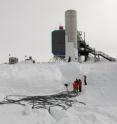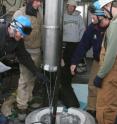IceCube neutrino observatory nears complete
In December 2010, IceCube -- the world's first kilometer-scale neutrino observatory, whiuch is located beneath the Antarctic ice -- will finally be completed after two decades of planning. In an article in the AIP's Review of Scientific Instruments, Francis Halzen, the principal investigator of the IceCube project, and his colleague Spencer Klein of Lawrence Berkeley National Laboratory provide a comprehensive description of the observatory, its instrumentation, and its scientific mission—including its most publicized goal: finding the sources of cosmic rays. "Almost a century after their discovery, we do not know from where the most energetic particles to hit the Earth originate and how they acquire their incredible energies," says Halzen, a professor of physics at the University of Wisconsin in Madison.
After light, neutrinos, which are created in the decay of radioactive particles, are the most abundant particles in the universe. High-energy neutrinos are formed in the universe's most violent events, like exploding stars and gamma ray bursts. Because the neutrino has no charge, essentially no mass, and only interacts weakly with matter, trillions of neutrinos pass through our bodies each day, without effect. On extremely rare occasions, a neutrino will strike the nucleus of an atom, creating a particle, called a muon, and blue light that can be detected with optical sensors. The trick is spying those collisions—and, in particular, the collisions of high-energy neutrinos. IceCube does it by sheer virtue of its size.
At 1 kilometer on a side -- with 5,160 optical sensors occupying a gigaton of ice -- the observatory is orders of magnitude bigger than other neutrino detectors; the Superkamiokande detector in the Japanese Alps, for example, is only 40 meters on a side.
"IceCube has been totally optimized for size in order to be sensitive to the very small neutrino fluxes that may reveal the sources of cosmic rays and the particle nature of dark matter," Halzen says.
Source: American Institute of Physics
Other sources
- Largest neutrino observatory readiedfrom UPITue, 31 Aug 2010, 21:35:11 UTC
- IceCube neutrino observatory nears completefrom Science BlogTue, 31 Aug 2010, 19:49:14 UTC
- IceCube neutrino observatory nears completionfrom Science DailyTue, 31 Aug 2010, 19:21:09 UTC
- IceCube Neutrino Observatory Nears Completionfrom Newswise - ScinewsTue, 31 Aug 2010, 18:35:32 UTC
- IceCube neutrino observatory nears completionfrom PhysorgTue, 31 Aug 2010, 18:35:24 UTC

